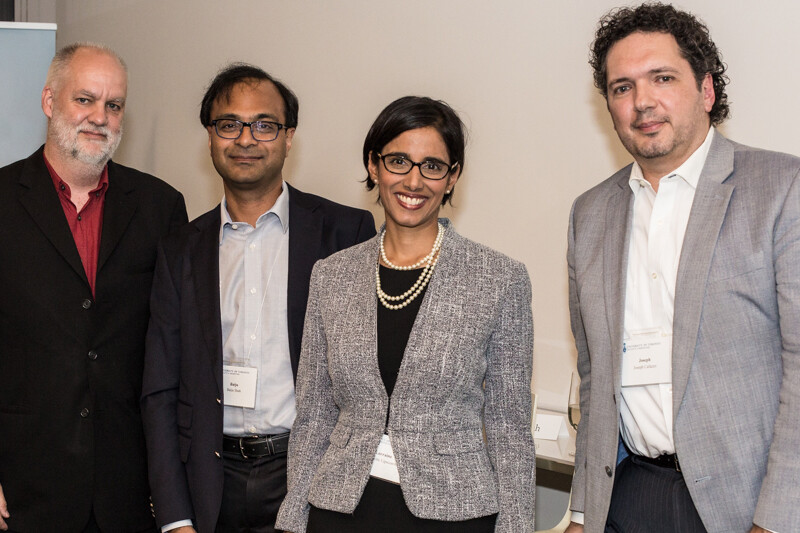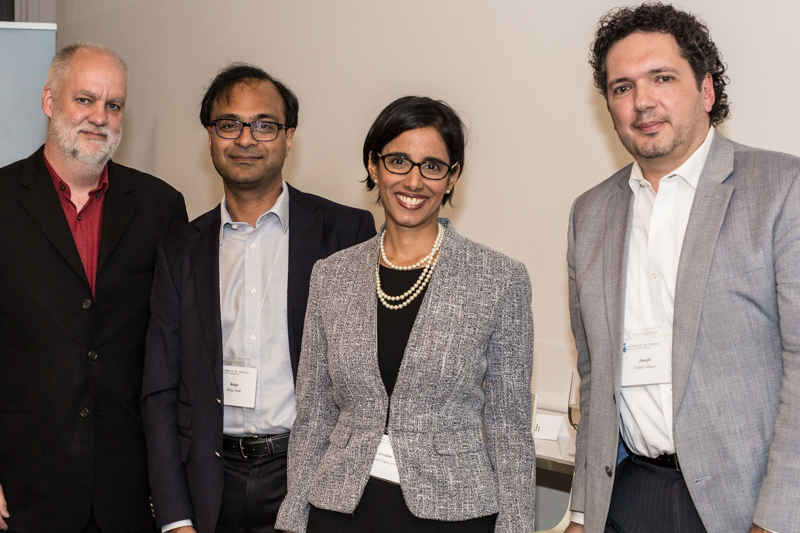Main Second Level Navigation
- Welcome
- Why Toronto?
- History of the Department
- Vision & Strategic Priorities
- Our Leadership
- Our Support Staff
- Location & Contact
- Departmental Committees
- Department of Medicine Prizes & Awards
- Department of Medicine Resident Awards
- Department of Medicine: Self-Study Report (2013 - 2018)
- Department of Medicine: Self-Study Report (2018 - 2023)
- Communication Resources
- News
- Events
André Picard, UofTMed Researchers on Insulin and Future of Diabetes

Carolyn Morris

“For once: a headline that was not an exaggeration,” said The Globe and Mail public health columnist André Picard, referring to his recent article entitled “Insulin: The Canadian discovery that has saved millions of lives.”
“Very few discoveries have had as much impact as insulin — especially 100 years later,” he said.
And yet, diabetes remains a major health challenge — and a growing one. Rates of type 2 diabetes are on the rise, and although insulin still serves as a lifesaving treatment for type 1 diabetics — it is not a cure. Complications from both types of diabetes can be devastating.
With one of the world’s largest concentrations of diabetes researchers, U of T is not resting on its laurels for the discovery of insulin, but is instead tackling the disease on multiple research and clinical fronts. This week’s UofTMedTalks provided a glimpse of this work, with the central threads of collaboration and patient focus connecting the work of panelists, Professors Baiju Shah, Lorraine Lipscombe and Joseph Cafazzo.
“Even a century ago, collaboration was a must,” said Picard, pointing out that the team behind insulin included a surgeon, a diabetes researcher, a biochemist and a student — as well as many other health care providers. Another essential factor was the interplay between the research lab and clinical care.
“I learn so much from patients,” says Shah, a health services researcher at U of T’s Department of Medicine and the Institute of Health Policy, Management and Evaluation (IHPME), and endocrinologist at Sunnybrook Health Sciences Centre. “Their experiences help guide my research.”
For example, one type 2 diabetes patient he refers to as Dave was blind, had chronic kidney disease and suffered from several other severe complications. Indigenous and living on a reserve, Dave relied on a friend to take him into town for appointments, struggled to find healthy and affordable food and to exercise. For Shah, he brought up questions around access to a healthy lifestyle, including: “How do you exercise when you can’t see?”
“While some researchers are focused on the next new treatment or technology, I try to make sure we’re using the technology and knowledge we already have,” says Shah, who is also a senior scientist at the Institute for Clinical Evaluative Sciences (ICES). “I’m able to take my learnings from Dave and convert them into research questions, then move that into health policy, so all of us can get better quality of care.”
Lipscombe also combines clinical and research work as she investigates the link between breast cancer survival and diabetes, and studies potential interventions based on shared risk factors — such as using diabetes drug metformin to help improve breast cancer survival.
As a clinician scientist in the Department of Medicine and at Women’s College Research Institute, Lipscombe has also developed a collaborative program to lower the risk of diabetes among new mothers who had gestational diabetes.
“I work with collaborators in kinesiology, nutritional sciences, nursing and psychology to provide follow up with these new mothers over the phone,” she says. “I know what women who’ve had gestational diabetes require, but I need these experts to deliver the right support — as well as the critical funding to build the program.”
Collaboration is key to Cafazzo’s work as well. As a biomedical engineer with U of T’s Institute of Biomaterials and Biomedical Engineering (IBBME) and IHPME, as well as head of the University Health Network’s Centre for Global eHealth Innovation, Cafazzo’s work focuses on how smart technology can bring care into patients’ own hands.
In working with teenagers diagnosed with diabetes, he helped devise a mobile application called bant, which gamifies diabetes care — giving kids points for measuring their blood sugar, for example.
He is increasingly involved in enhancing communications between devices, allowing patients themselves a break from thinking about their diabetes. Technologies such as the development of an artificial pancreas that can communicate directly with an insulin pump and adjust dosage automatically, for example, have the potential to improve outcomes while reducing the stress and constant monitoring people with diabetes struggle with.
“Many bioengineers never spend time with the patients they’re designing devices for, and that’s a big gap,” he says. “My job would be impossible without the collaboration with the hospital clinics and researchers — and through them, the patients themselves.”
As we approach the 100th anniversary of the discovery of insulin in 2021, U of T’s many leading diabetes researchers — spread across all Faculty of Medicine departments, and all U of T-affiliated hospitals — along with government and philanthropic supporters, are committed to making history once again.


